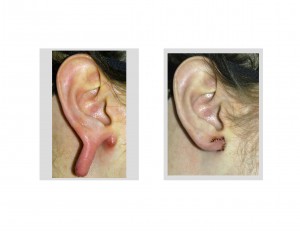Gauging the earlobe through sequential expansion devices seems relatively new, but it is a custom in some cultures that dates back well into antiquity. It is the earliest form of tissue expansion and proves that even the smallest body structure can be modified by simple pressure. While it is a fashion statement for some today, usually in younger patients, it often is not a body alteration that is maintained over one’s lifetime. Thus it is not uncommon today to see a ‘looped‘ earlobe in which the owner would like to see a more normal earlobe restored.
For small gauged ears, removal of the gauge will allow much of the hole to shrink down. Given a few months the hole in the ear will usually end up as just a small slit in the middle of the earlobe. This is a well known phenomenon that occurs in tissue expansion when the device is removed. It can be remarkable how large of an earlobe hole can close down of given enough time. It will still require surgery to put the earlobe edges back together but the smaller the hole the easier and more natural it will look. But in very large gauged ears or if one is in need of a more rapid closure, a different earlobe reconstructive approach is needed.
In the October 2014 issue of the journal Plastic and Reconstructive Surgery Global Open issue, an article appeared entitled ‘Repair of Massive Earlobe Piercing and Plus (Gauging)’ In this short case report, the authors report a single patient in which one earlobe had a 3 cm hole secondary to gauging over a seven year period. The gauge was removed sic weeks prior to surgical repair. The earlobe was repaired and closed using a pedicled skin flap from the inferior rim. The anterior aspect of the expanded earlobe skin was removed the lower skin flap rotated up into the defect to recreate a smaller and shorter earlobe.

Dr. Barry Eppley
Indianapolis, Indiana


